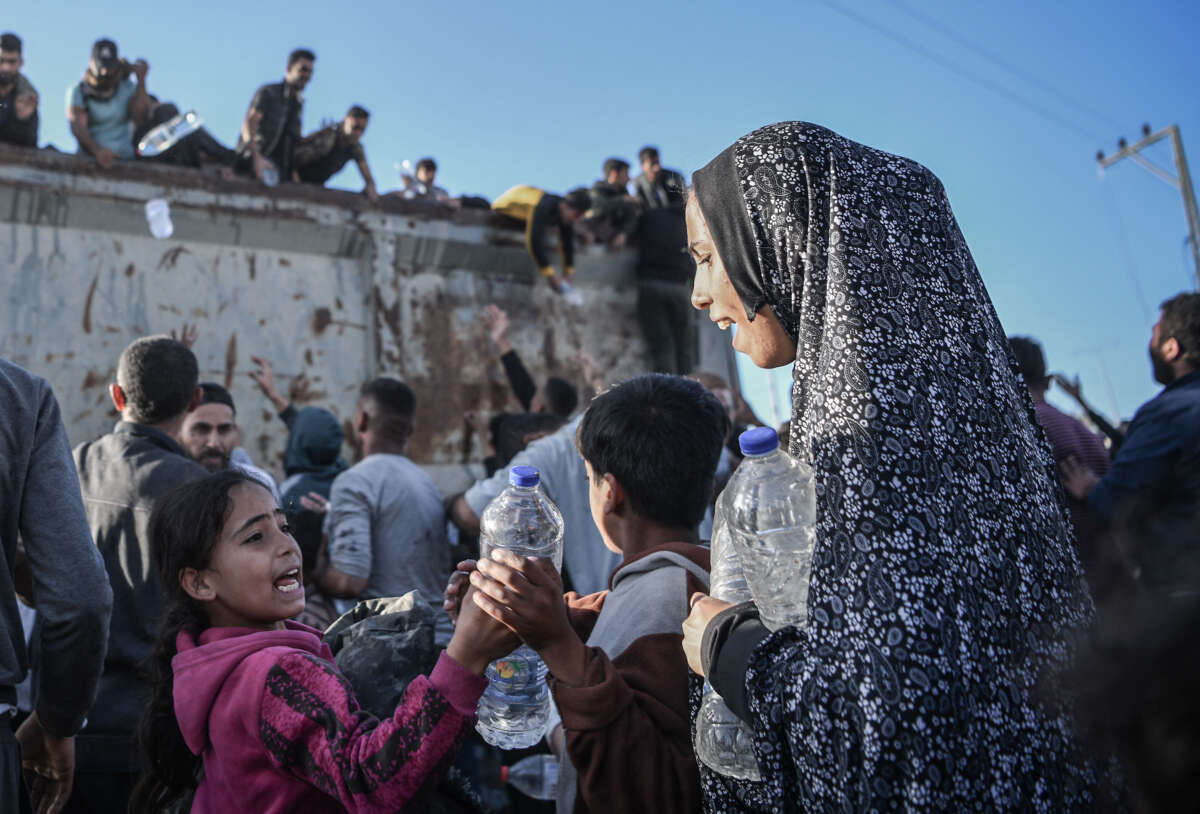Israel’s starvation campaign in Gaza is so severe that the vast majority of people across the world who are experiencing famine are located in Gaza, a UN food expert pointed out this week.
There are currently roughly 706,000 people in total across the world who are in populations experiencing “catastrophic” or “famine” levels of hunger, global food researchers have found. Of those people, about 577,000 are Palestinians in Gaza, according to a recent report by the UN-backed Integrated Food Security Phase Classification (IPC).
This means Palestinians in Gaza make up 80 percent of the global population that is currently experiencing famine, as chief economist for the UN World Food Program Arif Husain said in an interview with The New Yorker’s Isaac Chotiner published Wednesday. Some of the other countries facing some level of famine are Sudan, South Sudan and Somalia, according to the IPC.
Husain emphasized that the hunger crisis in Gaza, which IPC researchers have determined is acute across the entire region, is unprecedented in its severity.
“I’ve been doing this for the past two decades, and I’ve been to all kinds of conflicts and all kinds of crises. And, for me, this is unprecedented because of, one, the magnitude, the scale, the entire population of a particular place; second, the severity; and, third, the speed at which this is happening, at which this has unfolded, is unprecedented,” Husain said. “In my life, I’ve never seen anything like this in terms of severity, in terms of scale, and then in terms of speed.”
Husain also pointed out that the IPC report determined that the entire population of Gaza, or about 2.2 million people, will be under “full-fledged famine” within the next six months if Israel continues its blockade of food and other basic needs. The economist said that the escalating crisis is largely the result of Israel barring food from entering and being distributed in the region, adding that its relentless bombing campaign has endangered humanitarian workers and made it nearly impossible to distribute resources.
Famine is the worst level of hunger under IPC’s classification system, characterized by three main criteria, as Husain explained. First, more than 20 percent of a region’s population must be starving. The second is that 30 percent of children in the region must be malnourished or extremely thin, known as being “wasted.” Then, the mortality rate must be double the average rate.
Currently, Gaza is not classified as a full famine because its population only meets the first criteria, he said, but the population is on the way there. Roughly a quarter of the population has already reached the “famine” classification, while 50 percent are in the next highest classification of a food insecurity “emergency” and the rest are in an acute “crisis” of hunger, the IPC found.
“The bottom line is that, in Gaza, pretty much everybody is hungry at the moment,” Husain said.
“[Y]ou hope not to say, ‘O.K., let’s act because there is a famine,’” he added. “You need to act to avoid a famine, right? Because if you say, ‘O.K., let’s act when there is a famine,’ that means you’re saying people have already died, children are already wasted, people are already starving. That’s not the point. The point is that we should never let a population reach that state.”
Our most important fundraising appeal of the year
December is the most critical time of year for Truthout, because our nonprofit news is funded almost entirely by individual donations from readers like you. So before you navigate away, we ask that you take just a second to support Truthout with a tax-deductible donation.
This year is a little different. We are up against a far-reaching, wide-scale attack on press freedom coming from the Trump administration. 2025 was a year of frightening censorship, news industry corporate consolidation, and worsening financial conditions for progressive nonprofits across the board.
We can only resist Trump’s agenda by cultivating a strong base of support. The right-wing mediasphere is funded comfortably by billionaire owners and venture capitalist philanthropists. At Truthout, we have you.
We’ve set an ambitious target for our year-end campaign — a goal of $250,000 to keep up our fight against authoritarianism in 2026. Please take a meaningful action in this fight: make a one-time or monthly donation to Truthout before December 31. If you have the means, please dig deep.
